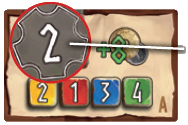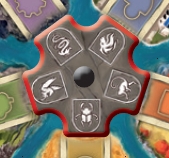Phase A
Phase A follow these steps:
Determine the first player and set the wheel 

Initiative
During epoch I, the player with the lowest-value initiative on their setup card
is the first player. During epoch II, the player with the second-lowest initiative
on their setup card is the first player. During epoch III, the player with the
thirdlowest
initiative
on their setup card is the first player. At the beginning of epoch
I, give 1 coin from the supply to each player who will not be the first player at
any point during the game.
 Example
Example: You set the wheel such that each player icon points to a deck.
This is possible only in a 4 or 5-player game.
2-player Game: During a 2-player game, the player with the lowest
initiative will be the first player during epochs I and III. Give the other player
1 coin at the beginning of epoch I.
The first player sets the wheel on the board such that
each player icon
points to a deck.
All players resolve this step simultaneously.
On Yucata this is simulated by resolving this step only after all players have made their choices.
Draw 2 cards from the deck your player icon is
pointing at.
Next, choose 1 of the 2 cards and place it faceup in the discard pile of the deck you drew it from (1). Finally, you
can either buy (2a) or sell (2b) the remaining card.
You cannot choose to discard both cards, buy both cards, or sell both cards.
(1) Discard 1 card to the discard pile
Place 1 of the 2 cards faceup in the discard pile of the
corresponding color.
(2a) Buy 1 card 
You can buy a card by paying its cost in coins, returning the coins to the
supply. The cost to buy a card is reduced based on the number of cards of
its color you already have. See “Reducing the cost of cards” below.
Once you have paid for a card, place it below your player board under the
corresponding color. Place cards of the same color on top of each other such that you
can see the values on each of them.
Most cards have values that add to one or more of your
tracks. When you buy a card, move the markers on your
tracks up based on the value(s) on the card.
You can check the values on your cards and tiles at any
time to ensure that your markers are correct.
Purple cards can have either values or effects. If the card you bought has an effect, then that effect
becomes available for you to use as soon as you buy it. See here a
summary of the purple card effects
.